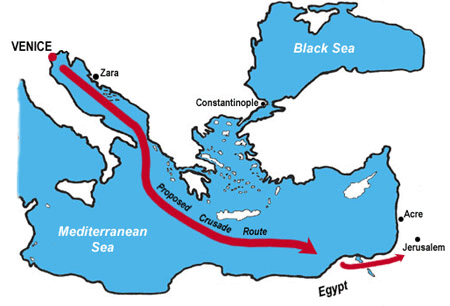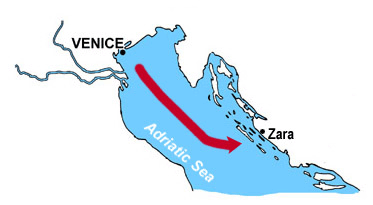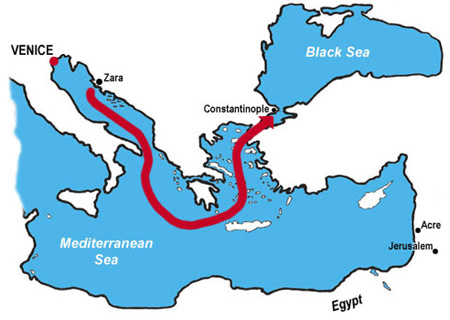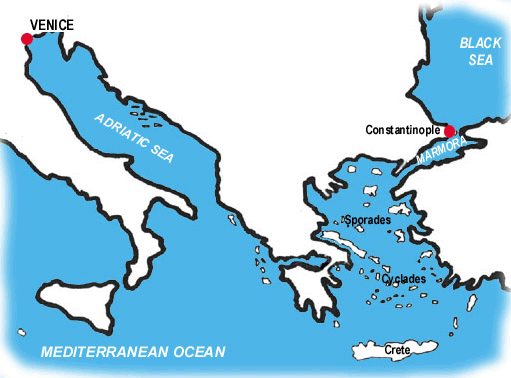Venice and the Fourth Crusade
No one has ever doubted that Doge Enrico Dandolo, the 39th Doge of Venice, was clever. His audacious appropriation of the forces of the Fourth Crusade to serve the ambitions of Venice is irrefutable evidence that he was a master of intrigue. The only question is whether he planned the events of 1201-1204 from the beginning or merely reacted brilliantly to opportunities as they unfolded. In the First Crusade a hundred years earlier the Europeans had captured Jerusalem, Acre, Tyre and other cities of the Holy Land and installed a Frankish monarch to govern the new kingdom. In the intervening period the Saracens had recaptured the territory and successfully defended it against the forces of the Second and Third Crusades (except for Acre, which was recovered by the Europeans in the Third Crusade). By 1200, under the urging of Pope Innocent, leadership had emerged in France and Germany for a Fourth Crusade, to be launched with a new strategy. The new plan was to attack the Saracens from the opposite direction, travelling by ship to Egypt and marching eastward and northward from there to the Holy Land. Only Venice had the resources for transporting an army such as the one the French and German leaders envisioned. In 1201 a delegation from the north arrived at Venice to commission construction of a new fleet of warships and transports for the enterprise. Venice agreed to supply, at a cost of 84,000 marks, transportation and nine months of provisions for a Crusader army of 4,500 knights and 19,000 squires and foot-soldiers. Moreover, Venice agreed to supply fifty additional galleys on her own, in exchange for the promise of one-half of any territory captured on the Crusade. June 1202 was set as the time for the Crusaders to gather at Venice, pay for the fleet and embark for the attack on Egypt. Did Doge Dandolo and the Venetians foresee already that the Crusaders had badly overestimated the size and financial resources of the army that they would gather? The evidence suggests that Dandolo may have already been working a separate agenda: at the same time that arrangements with the Crusaders were being concluded, Venice was also negotiating a treaty with Egypt that almost certainly included a mutual promise of non-aggression. Only in the following year did Venice's individual goals begin to surface. On June 24, 1202--the date agreed upon a year earlier--Venice had a magnificent fleet ready for the Crusaders of the Fourth Crusade. No Christian man had ever seen a richer or finer collection of vessels, reported one observer. If 4,500 French and German knights had arrived at Venice as promised by the Crusaders, or if those who did arrive had been able to pay 84,000 marks as agreed, perhaps the course of history would have been dramatically different. In fact, however, about 1,500 knights gathered and with only 50,000 marks available among them. In a last minute surprise, Doge Dandolo, at least 85 years old and functionally blind, announced that he had decided to become a crusader himself. On November 8, 1202, he embarked at the head of a fleet of 480 ships. Zara fell within a week in the face of such a powerful force, freeing the crusaders to proceed on their original mission to Egypt after wintering in Zara. New events were under way, however, leading--under Dandolo's guiding hand--to a new destination in the Spring: Constantinople, the capital of Byzantium, the Eastern Roman Empire. In the years at the beginning of the 13th century the Byzantine Empire, centered at Constantinople, was roiled by still another of its recurring dynastic struggles. Emperor Isaac II Angelus, a somewhat dotty ruler, had been deposed and imprisoned by his brother, who ruled as Alexius III. Dotty though he might be, Isaac II had nonetheless managed to arrange the marriage of his daughter to Philip, King of the German state of Swabia. Following the coup d'etat at Constantinople, Isaac II's son, also named Alexius, fled to the sanctuary of his German brother-in-law. There he and King Philip devised a fateful plan which they submitted formally to the wayward forces of the Fourth Crusade that were wintering at Zara. The proposal had two major elements. If the Crusaders would transport young Alexius to Constantinople, depose his usurping uncle, and install young Alexius as emperor, the new emperor would use his imperial powers to finance the Crusade in its conquest of Egypt. In addition, he would return the Eastern Orthodox Church at Constantinople to the authority of the Pope at Rome. The Crusaders--perhaps motivated as well by an unspoken third incentive, the possibility of plunder--agreed with only token defections. The mighty fleet arrived at Constantinople in June 1203, anchored at the Asian shore across the Bosporus from the Byzantine capital, and demanded that young Alexius be placed on the throne immediately. General attack on Constantinople followed on July 17. The Crusaders from France, attacking the city by land from the west, were halted and driven back. The Venetians attacked simultaneously by ship along the coast of the Golden Horn. They engaged tentatively at first, until suddenly one galley broke forward and drove its prow firmly and irrevocably onto the shore. Standing fully-armed at its prow was the ancient and blind Doge of Venice, Enrico Dandolo--a man for whom only victory was acceptable. None of the Venetian galleys dared hang back in the face of such daring and audacity. Soon the tide of battle swung firmly to the Venetians, who captured more than 25 of the defensive towers of the city. As night fell, Emperor Alexius III fled the city--pausing only to secure a reported five tons of gold and a bag of jewels. The Byzantines immediately restored Isaac II to the throne. By July 1 young Alexius, now Alexius IV, was installed as co-Emperor and his earlier promises for compensating the Crusader force were renewed. Their mission seemingly accomplished, the Crusaders returned to their encampment in Galata, across the Golden Horn, to await payment. Did anyone, except perhaps Doge Enrico Dandolo, perceive that the the following year would bring the sack of Constantinople and dismemberment of the Byzantine Empire? The rewards that Alexius IV had promised to the forces of the Fourth Crusade for assaulting Constantinople in July 1203 and placing him on the throne of the Byzantine Empire in his uncle's stead proved chimerical. Alexius's efforts to raise the funds through new taxes eroded his own support in the city. His promise to place the Byzantine Church under the authority of the Pope at Rome provoked still more anger and opposition. At the same time the Crusader forces, encamped across the Golden Horn at Galata, proved to be disruptive guests on their occasional forays into the city. With the onset of winter, events unravelled the expectations of all of the parties--with the possible exception of Doge Enrico Dandolo, who had longer vision and greater ambitions for Venice. The drama's final act began in January 1204. The Byzantine nobleman Alexius Ducas treacherously organized the assassination of the Angelus family's co-Emperors Isaac II and Alexius IV, arranged his own coronation as Alexius V, and moved swiftly to strengthen the city's fortifications against the renewed Crusader attack that was certain to follow by Spring. For the Crusaders, however, the first order of business was to decide how to divide the spoils that they confidently anticipated from their conquering and pillaging of the great capital city. Since they also intended to appropriate the throne of the Byzantine Empire for one of their own number, a secondary issue was to settle upon a method for selecting the new ruler.
The selection of the new ruler was placed in the hands of a 12-man
electoral committee. Six of the members were to be appointed by Doge
Dandolo and the Venetians, the balance by the other Crusaders. The
new Emperor, whoever he might be (and he was expected to be one of
the French noblemen among the Crusaders), would receive one-fourth
of Constantinople and the Byzantine Empire; the rest of the city and
empire would be allocated one-half to Venice and one-half to the other
Crusaders. With the serious business thus resolved, the war could begin. The assault, begun in April, was more difficult than the one of the prior year, but the Crusaders prevailed. Horrific looting of the world's richest city continued for days. Among the art treasures seized by the Venetians were the four graceful horses that now stand above the portal of the Basilica of St. Mark at Venice and the vast quantity of jewels and semi-precious stones that adorn the Basilica's pala d'oro. In geopolitical terms, however, Venice's greatest rewards were possession of the eastern shore of the Adriatic, the Cyclade and Sporade islands, and the shores of Thessaly, the Sea of Marmara and Black Sea, cementing its control of the trade routes from Europe to both Constantinople and Asia Minor. To these Venice quickly added--by treaty and by force of arms--the island of Crete, commanding the approach to the Adriatic Sea. |
RETURN TO MURANO GLASS HISTORY

 The
Venetian Doge Enrico Dandolo proposed a solution that would solve
two problems for Venice at one time: Venice would defer the balance
owed by the Crusaders for transportation and supplies if--while enroute
to Egypt--the Crusaders would assist the Venetians in recapturing
Zara, a city on the Dalmatian coast just across the Adriatic. Zara
had recently rebelled from Venetian rule and cast its lot with the
Kingdom of Hungary. The anomoly of Crusaders attacking a Christian
city was overlooked by most of the assembled Crusaders in light of
the financial shortfall they faced (though not by the Pope, who excommunicated
all of the participants).
The
Venetian Doge Enrico Dandolo proposed a solution that would solve
two problems for Venice at one time: Venice would defer the balance
owed by the Crusaders for transportation and supplies if--while enroute
to Egypt--the Crusaders would assist the Venetians in recapturing
Zara, a city on the Dalmatian coast just across the Adriatic. Zara
had recently rebelled from Venetian rule and cast its lot with the
Kingdom of Hungary. The anomoly of Crusaders attacking a Christian
city was overlooked by most of the assembled Crusaders in light of
the financial shortfall they faced (though not by the Pope, who excommunicated
all of the participants).
 Thereafter,
the Crusaders set about a swift and efficient plan of action. On July
5 they crossed the Bosporus and landed at Galata, the shore separated
from Constantinople by the broad river mouth known as the Golden Horn.
Their military objective at Galata was to capture the fortification
that protected one end of a tremendous iron chain that stretched across
the Golden Horn and secured the flank of the city from naval attack.
The mission was accomplished within a day and the chain was lowered.
The awaiting Crusader galleys swept in and destroyed the remnants
of the Byzantine fleet anchored there.
Thereafter,
the Crusaders set about a swift and efficient plan of action. On July
5 they crossed the Bosporus and landed at Galata, the shore separated
from Constantinople by the broad river mouth known as the Golden Horn.
Their military objective at Galata was to capture the fortification
that protected one end of a tremendous iron chain that stretched across
the Golden Horn and secured the flank of the city from naval attack.
The mission was accomplished within a day and the chain was lowered.
The awaiting Crusader galleys swept in and destroyed the remnants
of the Byzantine fleet anchored there.
